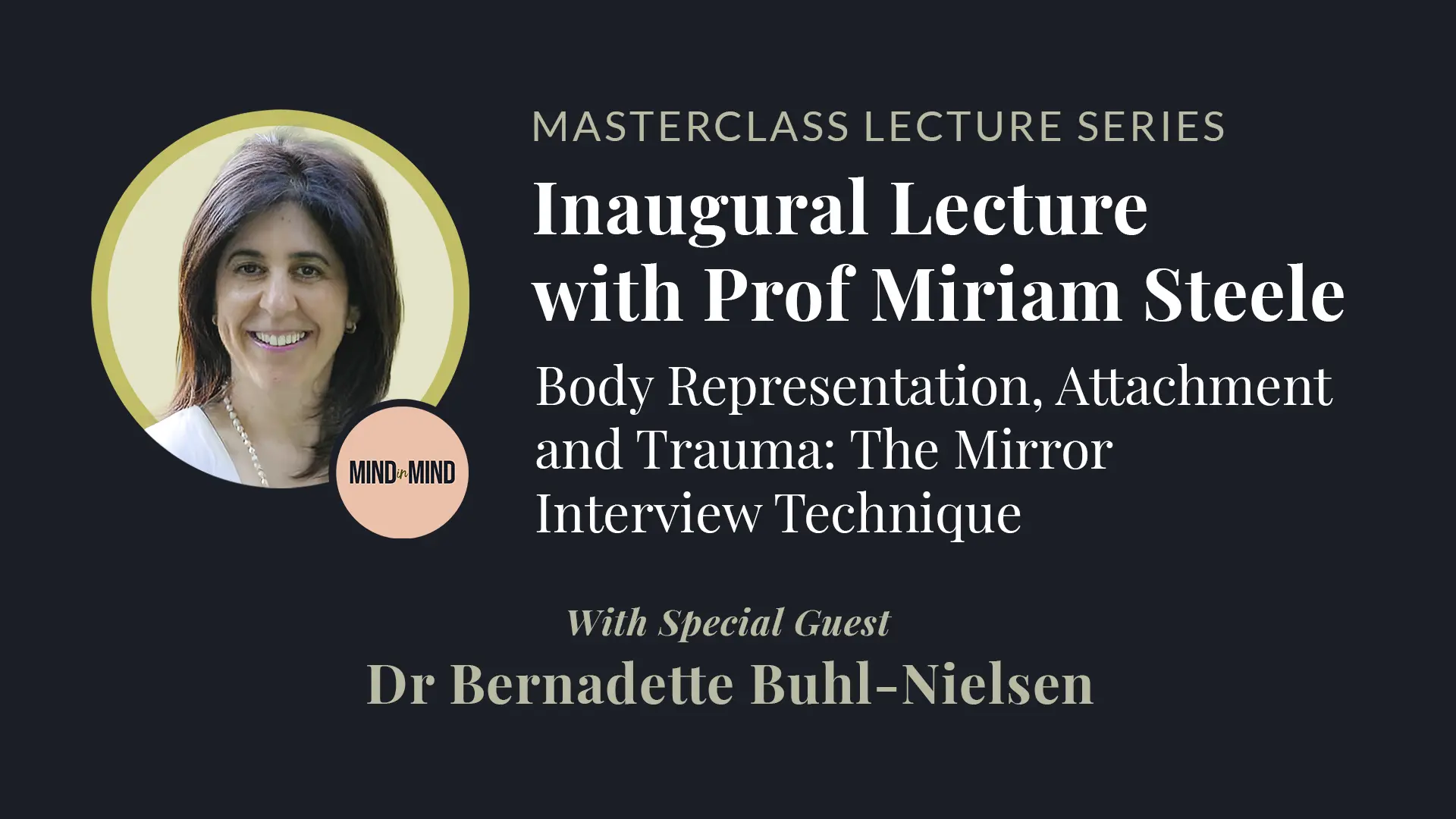June 2025
Stephen Porges and Sue Carter Live Legacy Interview
Stephen Porges and Sue Carter Live Legacy Interview
Join us for a special Live Legacy Interview exploring the life and work of Dr Stephen Porg...

– Watch the full recording for £39 includes a 2 hour CEU/CPD certificate –
With Special Guest
“The self is seen, and the self is felt, and the degree to which those are two very different aspects of one’s own sense of identity.”
“What really converted me almost immediately was how powerful it was to actually look at the mirror interview. The disgust and the shame and the depression, the sadness with which they looked at their bodies was overwhelming.”
Professor Miriam Steele launched the MINDinMIND Masterclass Series with her groundbreaking lecture exploring the intricate relationship between attachment, body representation, and trauma. Drawing on her pioneering research at The New School’s Center for Attachment Research, Miriam introduced the innovative Mirror Interview technique—a unique assessment that examines how individuals experience and relate to their own body image whilst revealing crucial insights into attachment patterns and intergenerational transmission.
The presentation demonstrated how this remarkable tool bridges the gap between psychoanalytic insight and empirical research, offering practitioners a window into the often-hidden world of body representations and their connection to early caregiving experiences. Through case examples, Miriam illustrated how the Mirror Interview reveals patterns of coherence, alienation, and reflective functioning that directly correlate with attachment classifications.
Dr Bernadette Buhl-Nielsen, co-developer of the Mirror Interview, enriched the conversation by sharing insights from her clinical work with adolescents, particularly those with personality disorders. Her research comparing healthy adolescents with those experiencing severe mental health difficulties revealed striking differences in how individuals relate to their mirror image – differences that have important implications for therapeutic intervention.
 Pioneering researcher in attachment theory, reflective functioning, and body representation
Pioneering researcher in attachment theory, reflective functioning, and body representation
Professor Miriam Steele stands as one of the most influential figures in contemporary attachment research and clinical practice. As the Alfred J. and Monette C. Marrow Professor of Psychology at The New School for Social Research in New York, she co-directs the Center For Attachment Research. Her work exemplifies the powerful integration of psychoanalytic thinking with rigorous empirical research, creating evidence-based approaches that have transformed how we understand and support vulnerable children and families.
Thirty years ago, as a PhD student at the Anna Freud Centre, Miriam initiated the concept of ‘reflective functioning’—a breakthrough that radically challenged existing child psychotherapy models. This concept, describing a parent’s capacity to understand both their children’s emotions and their own, has become foundational to modern mentalization-based treatments and has transformed our understanding of children’s attachment patterns and developmental trajectories.
Her longitudinal research has provided compelling empirical evidence demonstrating how parental states of mind significantly impact children’s social and emotional development. This work has been particularly influential in adoption and foster care, offering hope by showing how secure attachment relationships with adoptive parents can change the developmental course for children who have experienced early maltreatment.
Miriam’s commitment to bringing research into real-world settings is exemplified by her Group Attachment Based Intervention (GABI) for vulnerable families in the Bronx. This innovative programme demonstrates how psychodynamic principles can be effectively applied in underserved communities, supporting early relationships and emotional development where they are needed most.
Her current research into the intergenerational transmission of body image represents a groundbreaking expansion of attachment theory. By exploring how body representations are transmitted from mothers to daughters, and studying body image across diverse populations—including those with physical disabilities—her work provides crucial insights into eating disorders, body dysmorphia, and the growing challenges posed by social media objectification.
 Child and adolescent psychiatrist, psychoanalyst, and co-developer of the Mirror Interview technique
Child and adolescent psychiatrist, psychoanalyst, and co-developer of the Mirror Interview technique
Dr Bernadette Buhl-Nielsen is an internationally recognised child and adolescent psychiatrist and psychoanalyst whose innovative work has significantly advanced our understanding of body image, identity development, and psychological health in young people. Affiliated with the Department of Child and Adolescent Psychiatry at Region Sjælland and the University of Copenhagen, she brings together clinical expertise with cutting-edge research methodologies.
Working alongside the late Paulina Kernberg, Dr Buhl-Nielsen co-developed the Mirror Interview technique – a groundbreaking assessment tool that provides unique insights into the integration of body image and self-representation. This collaboration, born from a dinner conversation where Kernberg sketched out interview questions “on the back of an envelope,” has evolved into one of the most innovative clinical assessment tools in contemporary psychology.
Her research has revealed critical distinctions between “self as seen” and “self as felt,” particularly in adolescents with personality disorders. This work has shown how individuals with severe mental health difficulties often experience profound alienation from their body image—sometimes describing their reflection as “a dead person” or fearing it might “come out and attack” them.
Dr Buhl-Nielsen’s research spans continents, including groundbreaking work with refugee children in Chad and students in Tanzania. These studies have revealed how dramatically different cultural contexts shape body image development, with young people less exposed to social media showing remarkably positive and integrated body representations. One refugee child, despite experiencing horrific trauma, responded to questions about body dissatisfaction with genuine puzzlement: “How could I not like my body? God gave it to me.”
The MINDinMIND Masterclass Series brings together world-renowned clinicians and researchers to explore the evolving landscape of mental health theory and practice. These future-focused sessions examine current challenges, innovative therapeutic approaches, and cutting-edge evidence-based interventions, providing unique opportunities for professional development and critical discourse.
Professor Miriam Steele’s inaugural lecture, featuring Dr Bernadette Buhl-Nielsen, established the scholarly foundation for this innovative programme, demonstrating how rigorous research and clinical practice can inform and enrich each other in addressing some of the most pressing challenges in contemporary mental health care.
This masterclass is essential viewing for psychotherapists, psychologists, psychiatrists, social workers, mental health practitioners, researchers, and students interested in attachment theory, mentalization, body image, eating disorders, trauma, and the integration of psychoanalytic and empirical approaches to understanding human development.
Access to this recording qualifies for 2 CPD/CEU hours.
Miriam & Bernadette were in conversation with Jane O’Rourke.
Jane O'Rourke – Founder of MINDinMIND and former award-winning BBC journalist turned Child and Adolescent Psychotherapist. Jane brings a unique skill set to create rich and thoughtful conversations, weaving together the personal and professional threads of her guests' journeys.
Details correct at time of recording – 21 May 2025
Steele, H., Steele, M., & Fonagy, P. (1996). Associations among attachment classifications of mothers, fathers, and their infants. Child Development, 67(2), 541-555.
Steele, M., Hodges, J., Kaniuk, J., Hillman, S., & Henderson, K. (2003). Attachment representations and adoption: Associations between maternal states of mind and emotion narratives in previously maltreated children. Journal of Child Psychotherapy, 29(2), 187-205.
Buhl-Nielsen, B., & Kernberg, P. (2004). Mirrors, Body image and Self. Paper presented at the 6th Delphi International Psychoanalytic Symposium, Delphi.